Orthostatic Intolerance, the Chronic fatigue syndrome,
and the tilt table test ©
By Max Banfield
Definition: Orthostatic intolerance is the modern medical label for the most common type of FAINTNESS. It is due to a weakness of blood flow and usually occurs when the person suddenly moves from the laying to the standing position. The blood moves toward the feet under the influence of gravity, and instead of returning immediately to the brain, it stays there for a few seconds causing temporary faintness. (The word is derived from ‘Ortho’ which means straight (upright), and ‘stat‘ which means stand). See my YouTube which explains the nature of the faintness here The inefficient blood flow to the brain also reduces the supply of oxygen and nutrients which are carried by the blood. Consequently, there is also a tendency to abnormal tiredness. The inefficient circulation of blood throughout the rest of the body results in a reduced capacity for physical exertion. Some studies have shown that 97% of patients with the chronic fatigue syndrome have ‘orthostatic intolerance’ (see the references here), and some people are genetically disposed to it or are born with the problem, and it can affect individuals of all ages. The scientific evidence clearly indicates that the chronic fatigue is due to that factor in 97% of those cases, and that the other 3% had a different cause for their fatigue. |
Introduction to this page
I suggested using tilt table techniques as a method of diagnosing the symptoms of chronic fatigue thirty years ago when it was called Da Costa’s syndrome in standard medical books, and neurocirculatory asthenia in research journals.
At that time I had the problem and there weren’t any methods available for diagnosing the cause. One night, I also woke up with severe pain in the left side of my back which a doctor told me was due to kidney stones. In order to confirm that diagnosis I had an appointment for an x-ray about a week later. The clinicians strapped me onto a bed underneath an x-ray machine. Every few minutes they tilted me up or sideways to get pictures at different angles to check if there was a stone blocking the flow of fluid between the kidney and the bladder, and they confirmed that there was, so I had surgery to remove it soon after.
However, in the meantime, each time they tilted the bed I would feel extremely faint and weak in the chest, so I told them that I had been reading about my other ailment, and that there was no current method of diagnosing it, and that they could easily put their fingers on my wrist, and a blood pressure cuff on my arms and legs, and they would find very obvious and significant differences to the changes of pulse rate and blood pressure compared to healthy people. They would then be the first people in the world to have a useful way of diagnosing Da Costa’s syndrome, and scientifically proving that it was a real physical ailment and not an imaginary or mental problem.
See the link between the various names of the ailment in history here. See also here
A YouTube video of a tilt table test can be seen here
The biography of Greg Page
who became famous for his part in the singing group called The Wiggles
I recently read chapter 16 in the biography of Greg Page called “Orthostatic Intolerance” pages 268 to 284.
The book was called
“Now and Then
Greg Page
The life changing journey of the original yellow Wiggle”
It was published by HarperCollins Publishers in Sydney in 2011
He describes how he had been experiencing the problems of faintness, and breathlessness for many years, and despite seeing many doctors and specialists, and having numerous x-rays and blood tests, none of them could diagnose his ailment, or tell him what was causing all of the symptoms.
He explains how confused he was until he “had a further raft of tests that proved fruitless” until eventually he was given a tilt table test to confirm that he had a real physical ailment called “Orthostatic Intolerance“. He describes it as a circulatory disorder in which the blood in his body tends to pool in his lower body, with the blood flow to the brain being weak. Hence he sometimes feels faint when he moves from the laying to the standing position because the sudden affect of gravity on all of the blood in his body tends to draw it downwards and leave him faint and dizzy for a few seconds. More generally it is the reason he was having problems with fatigue.
Without my ideas and suggestions he and millions of other people would still be confused and unable to know or understand why they were having so much trouble with their health, and they would not know how to manage their symptoms.
I have not been able to contact him, so I would appreciate it if someone who reads this can bring it to his attention so that he knows why he is so fortunate to know the cause of his ailment and what to do about it.
Some relevant References
Banfield M.A. (1977 December) Does Glandular Damage play a role in those psychosomatic cases, Scientific Australian, p. 34-35.
Banfield M.A. 1980 January) Exhaustion in the effort syndrome, The Lamp (New South Wales), p.11.
Banfield M.A. (1980 April) Hypothetical Shock Mechanisms, Australasian Nurses Journal, p. 16-18.
Banfield M.A. (1980 December) S-bends, Australasian Nurses Journal, p.18-23.
Banfield M.A. (1982 5th August) Fitness helps in therapy, The “News “. p.13
Banfield M.A. (1982 20th August) S.A. study matches Russian results, The “News “. p.18
Banfield M.A. (1983 11th August) Study lifts fitness levels, The “News “. p.13
Banfield M.A. (1983 20th August) Researchers solve mystery, The Courier Mail (Queensland) p.14
Banfield M.A. (1983 22nd August) Cause of Mystery disease found, The West Australian (newspaper) p.14.
Banfield M.A. (1984 26th April) Hunt for mystery yawners, The “News “. p.23.
The actual research program design and results can be seen here
Note that the article in the Scientific Australian was written about my theory at that time, by the editor.
I wrote the essays which were published in The Australasian Nurses Journal and The Lamp.
The articles in the Adelaide afternoon newspaper called the “News” were about a research program which I was invited to design and organise for the South Australian Institute for Fitness Research and Training. The news items were written by Diane Beer, who was one of their medical editors.
There were several items in interstate newspapers which were written by a freelance journalist from Melbourne who verified the reliability of the information before writing it by contacting the head of the research institute.
See more about my research here
Banfield M.A. ( 2011 11th August) My YouTube on the symptom of faintness in CFS can be seen here
An independent modern Reference
Rowe P.C.(2002 April) Orthostatic Intolerance and Chronic fatigue syndrome: New light on an old problem, Journal of Pediatrics 140(4) p.387-9.
The following quotes are from the abstract of that article – “They described a group of patients who experienced excessive acceleration of the heart and hypotension after moving from the recumbent to the erect posture, usually associated with symptoms of orthostatic exhaustion, blurring of vision, weakness on exercise, and syncopal episodes.” . . . and . . .
“They concluded that this orthostatic tachycardia syndrome seemed similar to “effort syndrome, irritable heart, or neurocirculatory asthenia” the synonyms of the day for what we now call CFS.” See here
Another modern recommendation for using tilt table tests in diagnosing the Chronic fatigue syndrome (CFS)
I read the following article after I saw it mentioned in the news items on the website of the ME/CFS Australia (SA) Society of February 2012 and in their page of summary here
Reference: John Allen et al 2012, 25th January), Chronic fatigue syndrome and impaired peripheral pulse characteristics on orthostasis–a new potential diagnostic biomarker, Physiological Measurements. 33 p.231.
The following quote comes from that research paper. . .
“Chronic fatigue syndrome (CFS) is a debilitating condition that can affect all age groups and leads to significant impairment of quality of life . . . Despite this, the pathophysiology of CFS is not understood, although a number of reports suggest that . . . orthostatic intolerance is a common symptom that can be objectively assessed . . . One of the current difficulties in recognizing CFS has been the lack of a suitable diagnostic biomarker . . . In this study we investigated for the first time novel multi-site pulse wave parameters obtained from across the body in response to standing as a potential biomarker in CFS. The ultimate aim of the study was to allow us to improve our understanding of the underlying physiological abnormalities that arise in CFS with a view to informing future diagnostic tools and treatments.
Methods . . . Blood pressure was measured with the subject in the supine position at rest using a sphygmomanometer.
Multi-site PPG was used to examine the changes in pulse wave characteristics in response to a controlled orthostatic tilt test manoeuvre . . . PPG is a non-invasive optical technique which can easily detect clear pulse waveforms at peripheral body sites, i.e. the ear lobe, index finger pad, great toe pad . . . In this study we investigated the changes in multi-site beat-to-beat PPG pulse amplitude and timing changes with controlled orthostasis induced by head up tilt challenge at the ear, finger and toe sites . . .
The tilt protocol comprised a 10 min resting baseline measurement followed by a 70° controlled head up tilt for 3 min before returning to the horizontal level. This angle of tilt is a standard used in the Falls and Syncope Assessment Service within our hospital centre . . .
This study has confirmed that there are pulse wave abnormalities at rest and in response to orthostasis in the debilitating disease CFS that have the potential to be utilized as a bedside diagnostic marker to help identify which subjects might benefit from further clinical and objective assessment. This study is novel in that we have utilized state-of-the-art multi-site PPG technology to assess cardiovascular responses to controlled tilt.” (end of quote). The full article can be seen here
Note that my research since 1975 has had the same objective; namely to determine which methods could be used to show that the ailment was real and physical and not fake, trivial, imaginary, or mental.
I recommended the tilt table test then, and I also did become involved in a medically assessed fitness research programme which showed that pulse rate and blood pressure measurements could be used to diagnose the same problem, and the results confirmed it . See here
Up to 97% of CFS patients have Orthostatic Intolerance
According to the website of the CFIDS Association of America
The following quote comes from that website . . .
“The connection between OI and CFS was first introduced in 1995 by Peter Rowe, MD, and associates at Johns Hopkins University, who identified a type of OI called neurally mediated hypotension (NMH) in CFS patients. Since 1995, scientists have learned much more about the broader problem of OI in CFS. It is now thought that many CFS patients (up to 97% in some studies) have some form of OI and it seems to be a particular problem in young people with CFS.7,8,9,10.”
The references which were used to verify those statement were as follows
7. Stewart JM, Gewitz MH, Weldon A, Arlievsky N, Li K, Munoz J., Orthostatic intolerance in adolescent chronic fatigue syndrome. Pediatrics. 1999;103:116-21.
8. Rowe PC, Bou-Holaigah I, Kan JS, Calkins H,. Is neurally mediated hypotension an unrecognised cause of chronic fatigue? Lancet. 1995;345:623-4.
9. Stewart J, Weldon A, Arlievsky N, Li K, Munoz J., Neurally mediated hypotension and autonomic dysfunction measured by heart rate variability during head-up tilt testing in children with chronic fatigue syndrome. Clin Auton Res. 1998;8:221-30.
10.Stewart JM, Gewitz MH, Weldon A, Munoz J., Patterns of orthostatic intolerance: the orthostatic tachycardia syndrome and adolescent chronic fatigue. J Pediatr. 1999;135:218-25
See here.
See also a video about Orthostatic Intolerance by Peter Rowe here
My recommendations for using tilt table tests predates the current studies by more than a decade
Note that my recommendations for using Tilt table tests to diagnose the cause of chronic fatigue and faintness were developed between 1975 and 1984 when I had been studying the ailment, and experienced a worsening of symptoms while having a tilt table x-ray examination for kidney stones.
Researchers have a moral and ethical responsibility to acknowledge where they get their ideas from, and or, which studies predate their ideas, and who was the first to develop them.
In 1975 I had to deal with the difficultes of convincing people that I had a real illness, because I had been told that there was no scientific way of verifying that such a problem had a real physical basis, and that there was no way of diagnosing it.
Nowadays patients don’t have to deal with that problem, and get much better advice.
My Theory about Orthostatic Intolerance
Orthostatic Intolerance has two meanings. Firstly it has been used as another label for the chronic fatigue syndrome, and secondly, it actually refers to the sense of faintness which sometimes occurs when a person with CFS moves from the laying to the standing position because the flow of blood from the feet to the brain is inefficient.
Before reading this section I recommend that you scroll in and out of The Posture Theory diagram below, to see to see how leaning forward and back compresses the air and blood vessels in the chest and slows blood flow to the brain.
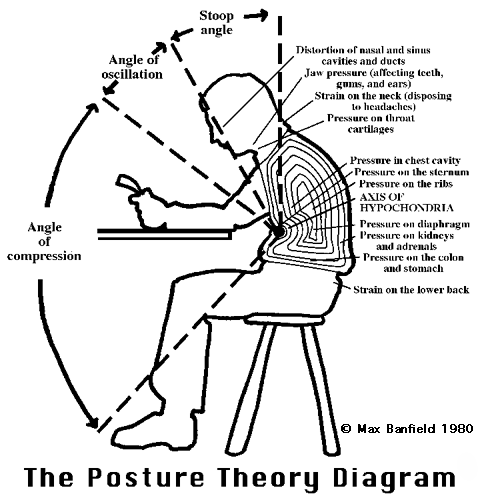
Scoll in and out of the diagram
Thirty years ago I noticed that sometimes when I leaned forward to read or write I would feel faint, and when I sat back the faintness would stop. When I mentioned this to my doctor he was unable to explain it. That symptom and many others became worse and more frequent so I began to study it myself.
About four years later I was searching for ideas when I found a comment on Valsalva’s maneuver which seemed as if it may be relevant so I thought about it for a couple of weeks and came to the following conclusions.
First of all the maneuver is usually done in scientific laboratories by asking a person to keep their mouth closed, and pinch their nose so that no air can escape, and then try to breath out with maximum force. The effect is to increase the air pressure in the chest. The effect is also evident because their cheeks of the face will bulge out under the pressure.
The increase in pressure in the chest and lungs also compresses the blood vessels and reduces the blood flow from the abdomen to the brain. The changes in blood pressure can be measured in the standard way.
I had already established that poor posture was the most likely cause of chest pains, breathlessness, and abdominal pains, so I concluded that leaning forward with such a posture would also increase the pressure of the air in the lungs and reduce the blood flow to the brain to cause faintness. The reduced blood flow to the brain would also make it difficult to concentrate and think clearly, and would increase the likelihood of abnormal tiredness. The pressure could also dam up the blood in the abdominal veins, and strain or damage them to make blood flow week, and cause a chronic tendency to such symptoms.
I was then able to write The Posture Theory with the conclusion that all of the symptoms were due to poor posture, namely chest pains, breathlessness, stomach pains, faintness, tiredness, and physical fatigue with a reduced capacity for exertion.
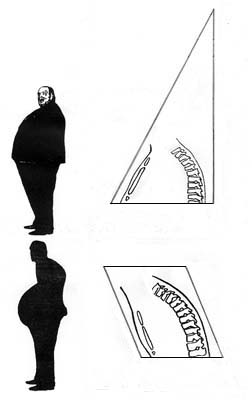
The top diagram (of the man) features the side profile of George MacAree who had the world’s largest chest measurement of 76 inches, or 193 cm according to the Guinness Book of Records, 1977 edtion.
I adapted the lower diagram from it to show a man with a flat chest to compare what would happen if they leaned forwards. M.B.
About fifteen or more years later, I was studying the problem and trying to determine why some people with poor posture would have these problems, and others didn’t?
I was then considering the fact that many of the patients had been described as having a ‘typical physique‘ which involved the ‘stooped or curved spine‘, and included a long, narrow, or flat chest.
It suddenly occurred to me that leaning forward from the hips, with a straight spine and a deep chest would cause the breast bone (or sternum) to go forward and over and around the abdomen without causing any pressure at all.
However, leaning forward with a stooped and curved spine and a flat chest would cause the sternum in front of the chest to move backwards and crush the chest and impair the blood flow going up from the abdomen.
(i.e. the first group would have a natural tendency to bend from the hips, and the second group would tend to bend from the waist).
Hence the stooped or curved spine, AND a flat chest would be the combination of features which had the most likely cause of symptoms.
I then recalled a time early in my studies when I joined an exercise programme in an attempt to overcome the fatigue. On one occasion I became involved in a relay, and had considerable difficulty running at the pace required, when the next event required me to place a medicine ball between my legs and frog hop to the wall about 20 yards away, and back again. After hopping in the squatting position for about ten yards my heart began to pound, and I fell forward gasping for breath. I was having great difficulty breathing for about fifteen minutes, and was unable to stand up and sit in a chair. When I eventually managed to get into the chair, I was feeling week and had to get out of it and crawl about on all fours on the floor for several more minutes. When I recovered sufficiently to get back to the chair I rested for a few more minutes, and then drove home, and it took me a week to recover before I could exercise again.
Several years later I was cleaning house windows, and did not have any difficulty with those at waist level, but on one occasion I was cleaning the windows of a house which has several small ones very low near the ground. While I was squatting down and leaning forward to clean them for about fifteen minutes, I had to stop each few minutes because it was making me feel faint and dizzy and weak, and when I finished I went home exhausted and went to bed in the afternoon and didn’t properly recover until the next day.
I also noticed, and described in my early essays, that I would sometimes feel faint if I leaned toward the kitchen sink to wash the dishes, or if I leaned toward the washing machine to lift clothes out, or if I leaned toward a bench. Also on one occasion I was driving my car when I was feeling quite exhausted, and I had to stop suddenly for a red light at a road intersection. As my body moved slumped forward toward the steering wheel I felt faint, and the sensation passed as I leaned back.
A reference from 1887 which measures the pressure on the internal cavities of the chest and abdomen which is exerted by tight corsets and leaning forward can be seen here. It was by Robert L. Dickinson and published in the New York Journal of Medicine on November 5, 1887 and was called “The Corset: Questions of pressure and displacement”.
Explaining the difference
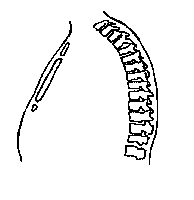
The deep chested slouch
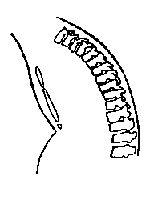
The flat chested slouch
In February 2003 The Pediatric Network presented some general information about “orthostatic intolerance” which is the type of faintness that I had been describing, and it stated on page 6, that the following postures can relieve the symptom because it “probably . . . reduces the amount of blood pooling in the intestinal circulation”?
“standing with one’s legs crossed
squatting
standing with one leg on a chair
bending forward from the waist (such as leaning over a shopping cart)
sitting in the knee-chest position
sitting in a low chair
leaning forward with the hands on the knees when sitting.” (end of quote)
However, it also states that “Some patients get worse if they adopt these postures.” (end of quote)
In my estimation the reason that some people benefit from those postures and others get worse is that some have deep chests which proceed forward and around the abdomen when they lean forward, and some have curved spines, or, in particular, flat chests which move backwards and compress than anatomy of the chest, and put downward pressure on the abdomen when they lean forward. (see the diagram above)
Full leg stockings, and corsets as a treatment???
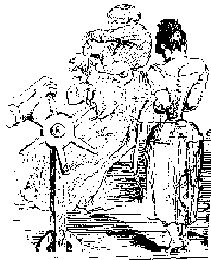
Corsets tightened from the outside.
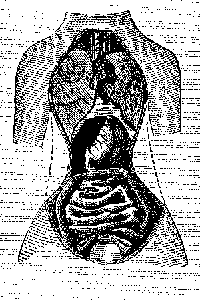
The crushing effect inside which impairs the blood flow from the abdomen to the brain to cause faintness.
An additional feature of my theory, which I developed between 1993 and 1999 was that similar symptoms were experienced by nineteenth century women because they wore tight waisted whalebone corsets which compressed the chest and abdomen and have the same effect on blood flow. The effect would vary between the high, mid, or low waisted corsets. The cause of symptoms could also be the result of the permanent displacement of the abdominal organs which are either pushed up or down, and become loosely attached and drop when the woman takes of her corset. My ideas about that are discussed in my book, and on other pages on this website.
However, the article about Orthostatic Intolerance recommends the use of full leg stockings and firm corsets to keep the veins of the legs straight so that their is maximum flow of blood upwards to the chest.
Extremely tight corsets can cause the symptom of faintness, and the chronic illness, so in some cases they should not be used at all. In others the corsets may be of benefit if they were ‘firm’ but not ‘tight’, and the recommendation would need to be made on an individual basis.
In some cases the wearing of tight belts, bands or corsets about the waist may not cause any obvious problems immediately, but it can cause extreme abdominal pain later in the day, and in the long term.
The full Reference for the Orthostatic Intolerance article is
February 2003: (No author mentioned), “The Pediatric Network, General Information Brochure on Orthostatic Intolerance and it’s Treatment, Chronic Fatigue Clinic, The web address where I found it cannot be found on the internet now but it was http://www.pediatricnetwork.org/medical/OI/johnshopkins.htm
A reference from 1930 about ‘neurocirculatory asthenia’
a previous label for ‘orthostatic intolerance’
The constitutional type occurred in children, youth, and early adult life . . . This type were generally tall and thin, with long narrow chests which are ’rounded in cross-section’, and forward curvature of the lower spine which pushed the abdomen forward into a ‘bottle-shaped’ appearance, and included visceroptosis with the internal organs positioned lower in the torso.
“The next commonest type is of course build. The chest is broad but flat.”
Symptoms: The pulse rate changes when they move from the upright to the reclining position, or in response to fear or other emotional stimulus, and they get palpitations with violent effort “such as the usual exercise test of hopping or forward bending” with the pulse rate taking up to several hours to return to normal. There is soreness in the skin on the left side of the chest in one quarter of cases, and in others there is general sensitivity in parts of the chest, but mainly in one rib space. Giddiness occurs mainly when getting out of bed, or with physical or emotional effort, and tends to become less noticed later in the day. Faintness or sometimes actual fainting occurs with patients reporting from 1 to 100 times, and is brought on by “the cessation of sudden effort, severe coughing attacks, deep breathing, the effort to stool, the sight of blood, a typhoid inoculation,, or a small pox vaccination”. In most cases the patient feels the faint coming on and sits down to avoid falling and injuring themselves. During the faint the pulse may become imperceptible but gradually return to normal after a few seconds or up to five minutes.
Reference: Rothschild Marcus A. (April 1930) Neurocirculatory Asthenia, The New York Academy of Medicine, Vol.VI, No.4, p.223-242.(Annual Graduate Fortnight, Functional and Nervous Problems in Medicine and Surgery, October 7 to 19, 1929)
See also my report of another book from 1930 which mentions poor posture and faintness in children here
My two critics in Wikipedia were “ridiculous”
While I was involved in Wikipedia I was providing useful information from my theory about poor posture compressing the air in the chest to cause faintness etc. but two rather offensive individuals were doing everything they could to insult me, and described all of my contributions as nonsense. They also deleted my edits, and then hid the fact that I was the source of the ideas.
However, I knew that they would not be able to provide their readers with good quality articles unless they stole that idea from me, and used it in some indirect way without mentioning my name.
I added information about the postural compression of the chest impairing blood flow to the brain to the page called Da Costa’s syndrome, on 18th December 2007 here.
At that time the page about Orthostatic Hypotension did not have any comments about that aspect here
The current version of that article includes this quote . ..
“Avoiding bodily positions that impede blood flow, such as sitting with knees up to chest . . . can help prevent incidents.” (See the last example here)
It could be written like this . . . “Avoiding a stooped posture which puts pressure on the chest and impedes blood flow between the abdomen and brain can prevent faintness.”
Summary
From The Posture Theory: Moving the chest toward the knees can cause faintness. Scroll in and out of the diagram here
From the current Wikipedia page about Orthostatic Hypotension: Moving the knees toward the chest can cause faintness. (See the last example again here)
This is a quote from the page about Da Costa’s syndrome which I added about my own theory at 00:58 on 18th December 2007 . . . “Pressure on the air and blood vessels in the chest impaired blood flow to the brain resulting in tiredness, and the resistance to blood flow affected the tone of the walls of the abdominal veins which weakened circulation and reduced exertional capacity.” (end of quote) here This is more relevant information which I added . . . “In 1916 Sir James MacKenzie chaired a major medical conference aimed at gaining a better understanding of the condition. He attributed the fatigue to the abnormal pooling of blood in the abdominal and peripheral veins during exertion, which reduced blood flow to the brain.” (end of quote) here My main critic deleted it five and a half hours later at 18:57 on 26th January 2009 here This is another quote from that page edited by my main critic at 16:30 on 11th August 2011 . . . “Causes− Orthostatic Hypotension is primarily caused by gravity-induced blood pooling in the lower extremities.” (end of quote) See here |
The following quote from Wikipedia, and also confirms that orthostatic intolerance is associated with the chronic fatigue syndrome, although it also contains some double talk. It also indirectly confirms that it is associated with Da Costa’s syndrome . . .
“POTS may be coexist with chronic fatigue syndrome as one of the CFS symptoms as part of the orthostatic intolerance of this condition. Treating POTS may improve some of the patients CFS symptoms.” (end of quote) here.
Here are some ideas they have copied from my theory . . .
“POTS symptoms can be worsened by postural asymmetries.” (end of quote). i.e. by abnormal forward curvature of the spine, which is also called poor posture or kyphosis, and sideways curvature of the spine which is called scoliosis.
This is an another quote from that Wikipedia article . . . “Exercise is very important for maintaining muscle strength and avoiding deconditioning. Though many POTS patients report difficulty exercising, some form of exercise is essential to controlling symptoms and eventually, improving the condition.
Aerobic exercise performed for 20 minutes a day, three times a week, is sometimes recommended for patients who can tolerate it.” (end of quote).
The offensive and ridiculous behaviour of my main critic should disgust the people who know that she was calling my ideas nonsense, but not criticising other editors who added the same principles. She should be ashamed of herself, and the other editors should show me a bit of gratitude, and acknowledge where the ideas came from.
Note also that POTS is put in the categories of cardiology, endocrinology, and syndromes here
However the same symptoms are described in the article about Da Costa’s syndrome but they have put it in the categories of and “Somatoform disorders” and “Anxiety disorders” here. It is just another example of how they are deceiving the public.
Compression of leg veins as a cause of faintness
I edited the Wikipedia page about “Varicose veins“, and added that they can be caused by tight leg garters, which block the upward flow of blood and cause the veins below the garters to swell up and bulge out to become varicose veins. Part of my theory is that the larger volume of blood in swollen veins can cause a tendency to temporary faintness when the person stands up suddenly because it takes them slightly longer to fill before the blood can return to the brain.
That information was deleted, and my main critic used the deletions as part of her argument that my ideas were nonsense. See my report by scrolling down from here and then see more details here.
However, the same thing is evident in the current version of the Wikipedia article about “Orthostatic Hypotension” where pressure of the leg straps in safety harnesses is used instead of the pressure caused by tight garters. This is a quote from that article . . . “While a harness may safely rescue its user from a fall, the leg loops of a standard safety or climbing harness further restrict return blood flow from the legs to the heart, contributing to the decrease in blood pressure. here
Obviously the effect of ‘garters’, and ‘leg straps’ are the same. My main critic knows that and her criticism of my contributions was childish.
Pressure from a full stomach, or a large womb, causing faintness
One of the statements in the Wikipedia article about “Orthostatic Hypotension” is that patients who feel faint should eat smaller meals. The reason is not mentioned, but it is because larger meals fill the stomach and increase it’s size and puts pressure on the blood vessels around it and hence reduces the blood flow from the legs to the brain. See where my main critic has edited that section at 18:52 on 12th May 2012 here, more than 3 years after I was banned, but she hasn’t called the idea nonsense. Also see an account of The Posture Theory and faintness here and here.
Again it is perfectly reasonable to suggest that a full stomach can cause faintness, in some people, in some circumstances. It is also perfectly reasonable to suggest that it is due to the pressure caused by the fuller stomach. For similar reasons, namely the enlarging womb, is why faintness is more common during pregnancy.
